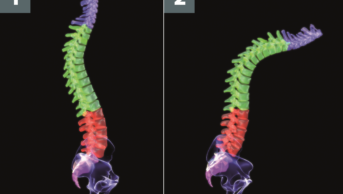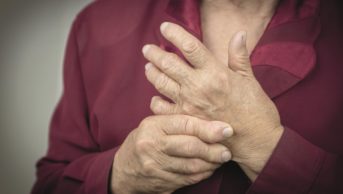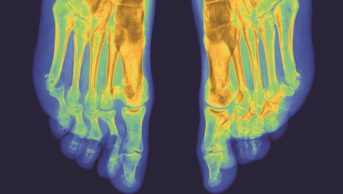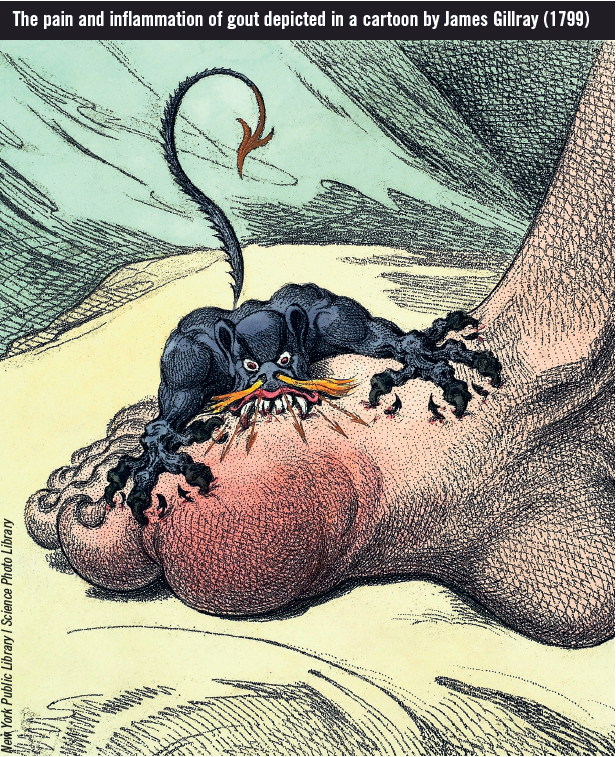
This content was published in 2012. We do not recommend that you take any clinical decisions based on this information without first ensuring you have checked the latest guidance.
Gout is a form of inflammatory arthritis that classically affects the small joints of the feet and hands, particularly the first metatarsophalangeal joint (big toe). Gout attacks are characterised by excruciating pain, redness and swelling of the affected joints.
Once believed to occur as a result of drops of poison falling into the affected joints, gout is now known to be caused by an inflammatory response associated with the deposition of monosodium urate crystals in the synovial fluid of joints and soft tissue. Acute gouty attacks often recur and, for some patients, contribute to the progression of chronic tophaceous disease leading to joint destruction and considerable disability. However, with appropriate anti-inflammatory and prophylactic therapy, gout can be controlled effectively for most patients.
In the UK the incidence of gout has increased over the past two decades. It is thought that factors that could be contributing to this increase are: a diet of excess; increasing alcohol consumption; an ageing population; and an increase in the prevalence of comorbidities such as obesity, hypertension and chronic kidney disease. Gout occurs more commonly in men than in women, with a male-to-female ratio of 3.6:1. It is rarely seen in pre-menopausal women. In the UK, the overall prevalence of gout is 1.4%1, but the prevalence is higher among people over 75 years of age (>7% for men and >4% for women)2.
Pathophysiology
Hyperuricaemia is one of the main risk factors for the development of gout. Despite this, only a small proportion of people with an elevated serum uric acid (SUA) level go on to experience a gout attack. Conversely, a substantial proportion of patients diagnosed with acute gout will have a normal SUA level. Ultimately, the higher the SUA level the higher the risk of gout. In population-based studies, the reported prevalence of hyperuricaemia is 15–20%2, 3.
Uric acid is the end product of purine metabolism and is excreted in the urine. Hyperuricaemia results from either underexcretion of uric acid (>90% of cases) or overproduction of uric acid (<10% of cases), or both. During purine metabolism hypoxanthine and xanthine are converted to uric acid by the enzyme xanthine oxidase (see Figure 1). This pathway is the main focus for gout treatments (see accompanying article, p79). Unlike other mammals, humans lack the enzyme uricase and are therefore unable to convert uric acid to freely soluble allantoin. As a result, monosodium urate crystals can form4.
Urate crystals
In hyperuricaemia, the concentration of uric acid in the serum reaches the saturation point and needle-like crystals of monosodium urate form. A reduction in serum pH and temperature facilitates further uric acid precipitation. These crystals form, initially, in the small joints of the feet and hands and long-term hyperuricaemia can cause these crystals to deposit in the surrounding soft tissue.
Urate crystals can collect in the urinary tract and form stones. Low urine pH (<5.5) is an important risk factor for the formation of uric acid crystals in the urine and stone formation. Causes of low urine pH include chronic diarrhoea, severe dehydration and renal tubular disorders. Urate crystals can also combine with calcium oxalate to form mixed urinary stones. These stones can cause urinary obstruction and affect kidney function.
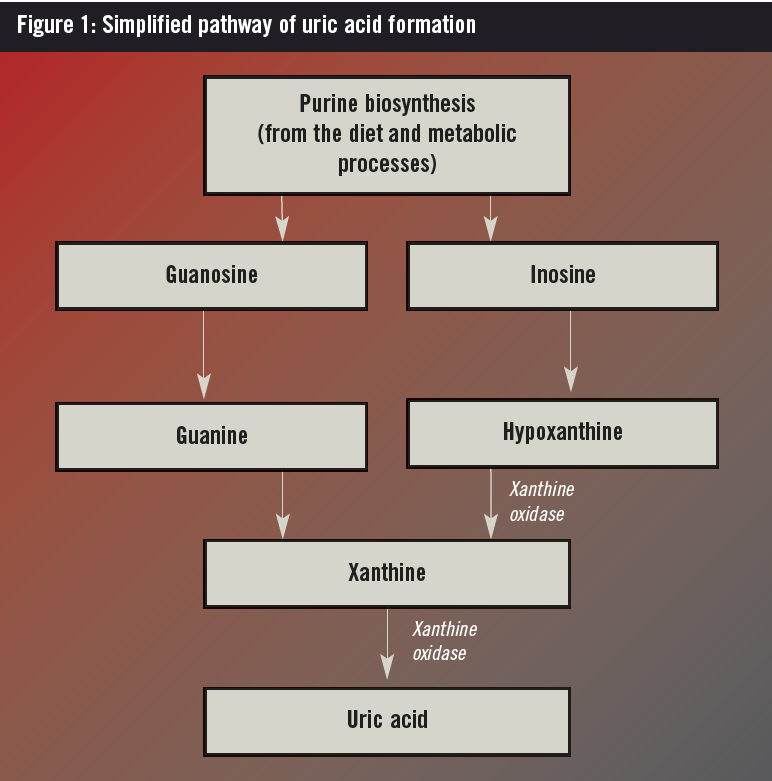
Clinical features
Gout can be classified according to four phases, described below.
Asymptomatic hyperuricaemia
A person can have hyperuricaemia, but not develop any symptoms of gout. This is termed “asymptomatic hyperuricaemia” and does not usually require treatment.
Acute gout
The symptoms typically associated with gout — severe pain, tenderness and swelling — occur in the acute phase.
Generally, on initial presentation, only one joint is affected by acute gout (monoarticular arthritis), and in 50% of cases the first metatarsophalangeal joint is the one involved. Other joints commonly affected include the foot, ankle, knee, wrist, finger and elbow. These peripheral joints are thought to be more susceptible due to their cooler physiological temperature, which facilitates urate crystallisation5.
An episode of acute gout often begins in the early hours of the morning. Often, the first symptom patients will describe is an itching sensation, thought to be caused by prodromal mast cell degranulation and release of histamine6. An intense pain follows and reaches a peak within a few hours. There is heightened sensitivity of the skin covering the affected joint, or joints, which may be so extreme that even the sensation of a bed sheet over it cannot be tolerated.
This acute phase is usually self-limiting, spontaneously resolving within one to two weeks. More severe episodes can involve many joints and systemic symptoms (polyarticular disease), although this is more common with recurrent attacks1. Although many acute episodes do not have an obvious cause, attacks can be triggered by the factors listed in Box 1.
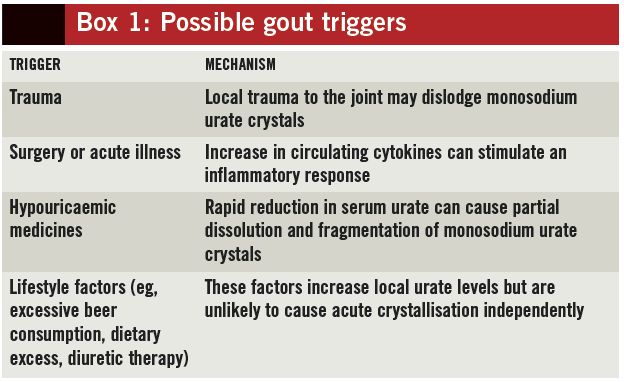
Intercritical or interval gout
Once the first episode of acute gout resolves, usually in seven to 14 days, a symptom free period will follow — this is termed “intercritical gout”. The duration of this asymptomatic phase can vary widely from several days to years. Although some patients will never have another attack, for most the second attack occurs within a year. Over time, and without appropriate prophylaxis, the time between acute episodes gradually shortens and, eventually, chronic tophaceous gout can develop.
Chronic tophaceous gout
The most disabling stage of the condition is chronic tophaceous gout, which usually develops over an extended period. Chronic tophaceous gout has become rare since the introduction of effective long-term prophylactic therapy. This stage of gout is characterised by clinically apparent tophi (subcortical cysts) that form within joints previously affected by acute gout. Chronic gout tends to be more of a problem for patients in whom prophylactic therapy is contraindicated or poorly tolerated (e.g., those with allopurinol hypersensitivity or chronic kidney disease). Chronic tophaceous gout causes permanent damage to the affected joints. Kidney damage is also common in this stage.
Risk factors
Hyperuricaemia has been identified as the most important risk factor for the development of gout. The Framingham Heart Study highlighted the link between the risk of developing gout and elevated SUA levels. This relationship has also been alluded to in other studies, such as a Taiwanese cross-sectional study where the incidence of gout increased exponentially with increasing SUA levels2. Other risk factors for the development of gout include7:
- Older age;
- Male sex (the risk is also higher for postmenopausal women than for premenopausal women);
- High alcohol consumption (particularly beer and spirits);
- Diet rich in meat and seafood;
- Genetics (mutation of urate transporter genes);
- Hyperglycaemia;
- Obesity.
Some medical conditions are known to cause hyperuricaemia and therefore increase the likelihood of gout developing. This can occur through increased purine synthesis (eg, thalassaemia, chronic haemolytic anaemia and glucose-6-phosphate dehydrogenase deficiency) or reduced renal excretion of uric acid (eg, hypertension, hypothyroidism, sickle cell anaemia, hyperparathyroidism and chronic kidney disease).
There is a strong association between gout and cardiovascular disease and there has been much debate about whether or not gout can be regarded as an independent risk factor for the development of coronary heart disease. In the Framingham Heart Study an increased incidence of coronary heart disease was identified in men with gout (5.8/1,000) compared with those without the condition (3.8/1,000). However, many of the risk factors for gout are also associated with an increased risk of developing cardiovascular disease.
Diagnosis
The European League Against Rheumatism (EULAR) has set out diagnostic criteria for gout, based on clinical findings. Rapid development of severe pain, swelling and tenderness that reaches a peak in six to 12 hours, in combination with overlying erythema, is likely to indicate crystal inflammation.
The definitive diagnostic test for gout is the identification of urate crystals in synovial fluid aspirated from an affected joint. However, in practice this test is not carried out often (only in 11% of cases)1. According to the American College of Rheumatology, presence of six or more of the following clinical features indicates a diagnosis of gout8:
- More than one attack of acute arthritis;
- Maximum inflammation developing within 24 hours;
- Attack of monoarthritis;
- Erythema over the affected joints;
- Painful or swollen first metatarsophalangeal joint;
- Unilateral attack on tarsal joint;
- Tophus (suspected or proven);
- Hyperuricaemia;
- Asymmetric swelling within a joint witnessed via radiography;
- Subcortical cysts without erosions visible on a radiograph.
Joint fluid culture negative for organisms during the acute attack Another tool used for the diagnosis of gout is the Janssens clinical prediction rule. It sets out seven criteria and attributes a score for each criterion met. If a patient scores <4 a diagnosis of gout is highly unlikely. If a score of >8 is achieved then it is more than 80% likely that gout is an accurate diagnosis. The criteria are outlined in Box 29.
Patients who score 8 or more using the Janssens clinical prediction rule should be started on empirical treatment pending laboratory results (such as SUA level).
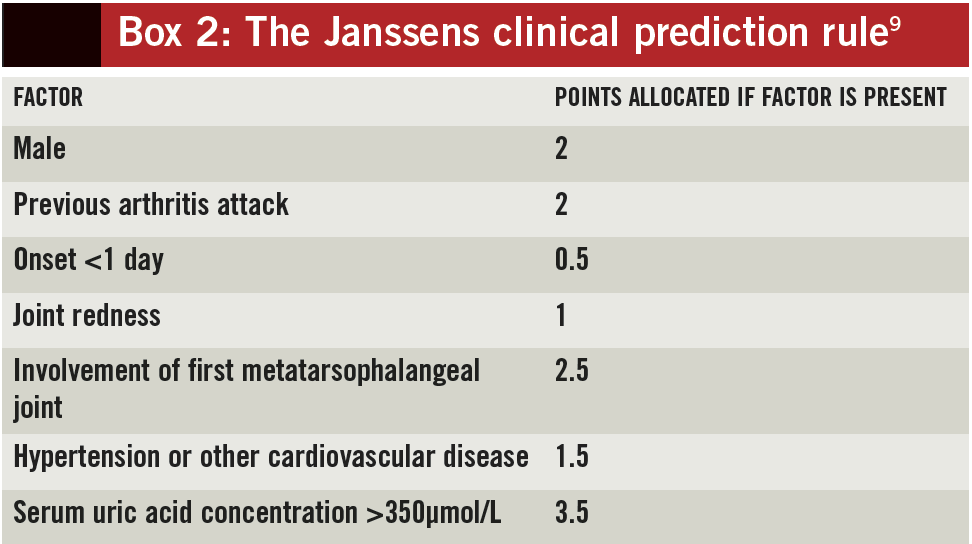
Differential diagnosis
The most notable differential diagnosis for acute gout is septic arthritis. Septic arthritis is usually associated with intra-articular fluid and the aspirate normally contains a raised leukocyte count and a positive Gram stain. Other differential diagnoses which must be considered include cellulitis, arthritis (rheumatoid, psoriatic or reactive), calcium pyrophosphate deposition disease (pseudogout) and haemochromatosis.
Summary
Gout is a form of inflammatory arthritis caused by the deposition of urate crystals into the affected joints. The main risk factor for gout is hyperuricaemia, which can be brought about by overproduction or underexcretion of uric acid. Gout can be classified into four phases: asymptomatic hyperuricaemia; acute attacks (characterised by the classic symptoms of gout — pain, swelling and erythema of the affected area); interval gout (the symptom free period between episodes); and chronic tophaceous gout (in which tophi develop in the joints that are affected by repeated, acute episodes).
References
1. Roddy E & Doherty M. Epidemiology of gout. Arthritis Res Ther 2010;12:223–33.
2. Jordan KM, Cameron JS, Snaith M et al. British Society for Rheumatology and British Health Professionals in Rheumatology Guideline for the Management of Gout. Rheumatology 2007;46:1372–4.
3. Doherty M. New insights into the epidemiology of gout. Rheumatology 2009;48(supp 2):ii2–ii8.
4. Neogi T. Gout. N Engl J Med 2011;364:443–52.
5. Underwood M. Diagnosis and management of gout. BMJ 2006;332:1315–9.
6. Suresh E. Diagnosis and management of gout: a rational approach. PMJ 2005;81:572–9.
7. Cayley WE. Gout. BMJ 2010;341:c6155
8. Wallace SL, Robinson H, Masi AT et al. Preliminary criteria for the classification of the acute arthritis of primary gout. Arthritis Rheum 1977;20:895–900.
9. Janssens HJ, Fransen J, van de Lisdonk EH et al. A diagnostic rule for acute gouty arthritis in primary care without joint fluid analysis. Arch Intern Med 2010;170:1120–6.
